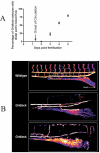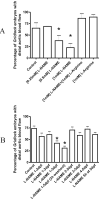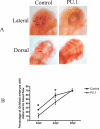Ischemia is not required for arteriogenesis in zebrafish embryos
- PMID: 17656667
- PMCID: PMC2517163
- DOI: 10.1161/ATVBAHA.107.143990
Ischemia is not required for arteriogenesis in zebrafish embryos
Abstract
Objective: The role of ischemia in collateral vessel development (arteriogenesis) is a contentious issue that cannot be addressed using mammalian models. To investigate this, we developed models of arteriogenesis using the zebrafish embryo, which gains sufficient oxygenation via diffusion to prevent ischemia in response to arterial occlusion.
Methods and results: We studied gridlock mutant embryos that suffer a permanently occluded aorta and show that these restore aortic blood flow by collateral vessels. We phenocopied gridlock mutants by laser-induced proximal aortic occlusion in transgenic Fli1:eGFP/GATA1:dsRED embryos. Serial imaging showed these restore aortic blood flow via collateral vessels by recruitment of preexisting endothelium in a manner similar to gridlocks. Collateral aortic blood flow in gridlock mutants was dependent on both nitric oxide and myeloid cells. Confocal microscopy of transgenic gridlock/Fli1:eGFP mutants demonstrated no aberrant angiogenic response to the aortic occlusion. qPCR of HIF1alpha expression confirmed the absence of hypoxia in this model system.
Conclusions: We conclude that NO and myeloid cell-dependent collateral vessel development is an evolutionarily ancient response to arterial occlusion and is able to proceed in the absence of ischemia.
Figures





References
-
- Scholz D, Cai WJ, Schaper W. Arteriogenesis, a new concept of vascular adaptation in occlusive disease. Angiogenesis. 2001;4:247–257. - PubMed
-
- Heil M, Schaper W. Pathophysiology of collateral development. Coron Artery Dis. 2004;15:373–378. - PubMed
-
- Prior BM, Lloyd PG, Ren J, Li Z, Yang HT, Laughlin MH, Terjung RL. Arteriogenesis: role of nitric oxide. Endothelium. 2003;10:207–216. - PubMed
-
- Lloyd PG, Yang HT, Terjung RL. Arteriogenesis and angiogenesis in rat ischemic hindlimb: role of nitric oxide. Am J Physiol Heart Circ Physiol. 2001;281:H2528–2538. - PubMed
Publication types
MeSH terms
Substances
Grants and funding
LinkOut - more resources
Full Text Sources
Other Literature Sources
Molecular Biology Databases

